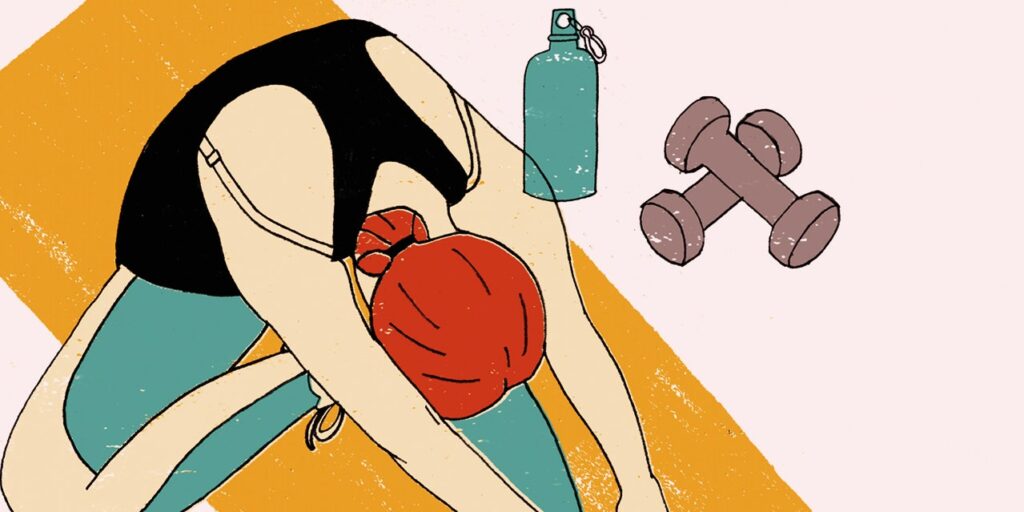This also means I won’t speak like this in my classes. I may talk about body parts in relation to which muscles to engage, how it can help with other types of movement you do, or where you might feel something, but not to what the aesthetic results will look like. You might hear some F-bombs (from me or my music), but I truly feel this is far less detrimental than what I have heard about bodies in classes before.
3. I avoid labeling food and exercise as good or bad.
I don’t label foods as good or bad or how someone eats as “being good today” (or bad), because this is what filled my consciousness while I was in the throes of my eating disorder. I’m also not a fan of labeling movements or workouts as “fat-burning” or “slimming” or anything of the sort. Same goes for class names. I don’t mind body-part focus (like Upper Body, Lower Body, or Core), but when a class or program is labeled by its aesthetic promise—Six-Pack Abs, anything shred-related—I have to stay away. The great news, though, is that this has led me toward some amazing modalities, classes, and coaches in which form, function, solid movement patterns, and athleticism take the front seat.
4. I’m not afraid to mute or unfollow certain social accounts.
I just know that as I scroll my feed, there are certain things I cannot afford to see. Before-and-after transformation photos, posts where people criticize their own bodies, the peddling of products related to weight loss, any comments about people being lazy because they don’t work out or eat a certain way, memes or posts about COVID weight gain, or anything of that nature need to be banished from my sight.
I instead seek those who are body neutral, super real, and extra candid and who aren’t afraid to call B.S. on industry and societal ideals. I will quickly hit “follow” on accounts that promote healthy relationships with body and mind, dietitians who specifically counter this weight-loss-focused culture, fitness accounts that are focused on function over aesthetic, and accounts that speak up for inclusion.
5. I am very specific about the brands I choose to work with.
If they have diet, weight loss, bikini, booty, six-pack, or anything of the sort in their title or as part of the ethos of the brand, I won’t move forward with them. I’ve turned down product deals, articles, and features because I just couldn’t be involved, and I will continue to do that without hesitation. Now, I cannot always control article headlines, which may change before print, for pieces I ’ve been quoted in or photographed for, or have contributed to. But when I can help it, I most certainly do.
6. I check myself regularly.
I am well aware that my thoughts, behaviors, patterns, and emotions can quickly become unhealthy. I can’t exist in a hole where I’ve banished all eating disorder triggers away from me, so there are still many that come across my world daily. If I can catch myself in the act of a negative thought pattern, I can generally talk myself out of it, which often includes taking a moment (or many) to reframe my thoughts from what my body looks like to what my body can do. The longer I let a negative thought sit, the more likely it is to snowball.
7. I listen intently to my body.
I find that the more in tune I am with what my body needs, the better off I am overall. This helps me prevent injury, nourish and replenish myself with the proper fuel, get sufficient sleep, get adequate body care, and take care of my emotional health. It helps me be more precise with the actual self-care that my body needs instead of altering my behaviors to achieve an external ideal. For example, if my body needs fuel, I give it fuel instead of overthinking what I “should” or “should not” be eating.
8. I stay consistent with my therapy.
My eating disorder was rooted in trauma—and I know I’m not alone in that—which means not only do I need to stay on top of the behavioral manifestation that ensued, but I also really need to consistently go at the root of the issue as well. This is a lifelong process that ebbs and flows, and consistently checking in makes a huge difference. Checking in with a professional is ideal and can be life-changing. But I also know that not everyone has the ability or means to access a therapist. If you don’t, try to find online or library resources created by professionals to get some insight or look for groups of people dealing with similar issues.

